2018 CHRYSLER PACIFICA HYBRID heating
[x] Cancel search: heatingPage 425 of 614

For more information on the Cap-Less Fuel System refer to
“Refueling The Vehicle” in “Starting And Operating” in
this manual.
IF YOUR ENGINE OVERHEATS
In any of the following situations, you can reduce the
potential for overheating by taking the appropriate action.On the highways — slow down.
NOTE:
There are steps that you can take to slow down an
impending overheat condition:
• If your air conditioner (A/C) is on, turn it off. The A/C
system adds heat to the engine cooling system and
turning the A/C off can help remove this heat.
• You can also turn the temperature control to maximum
heat, the mode control to floor and the blower control to
high. This allows the heater core to act as a supplement
to the radiator and aids in removing heat from the
engine cooling system.
WARNING!
You or others can be badly burned by hot engine
coolant (antifreeze) or steam from your radiator. If you
see or hear steam coming from under the hood, do not
open the hood until the radiator has had time to cool.
Never try to open a cooling system pressure cap when
the radiator or coolant bottle is hot.
Emergency Fuel Fill Funnel
7
IN CASE OF EMERGENCY 423
Page 427 of 614
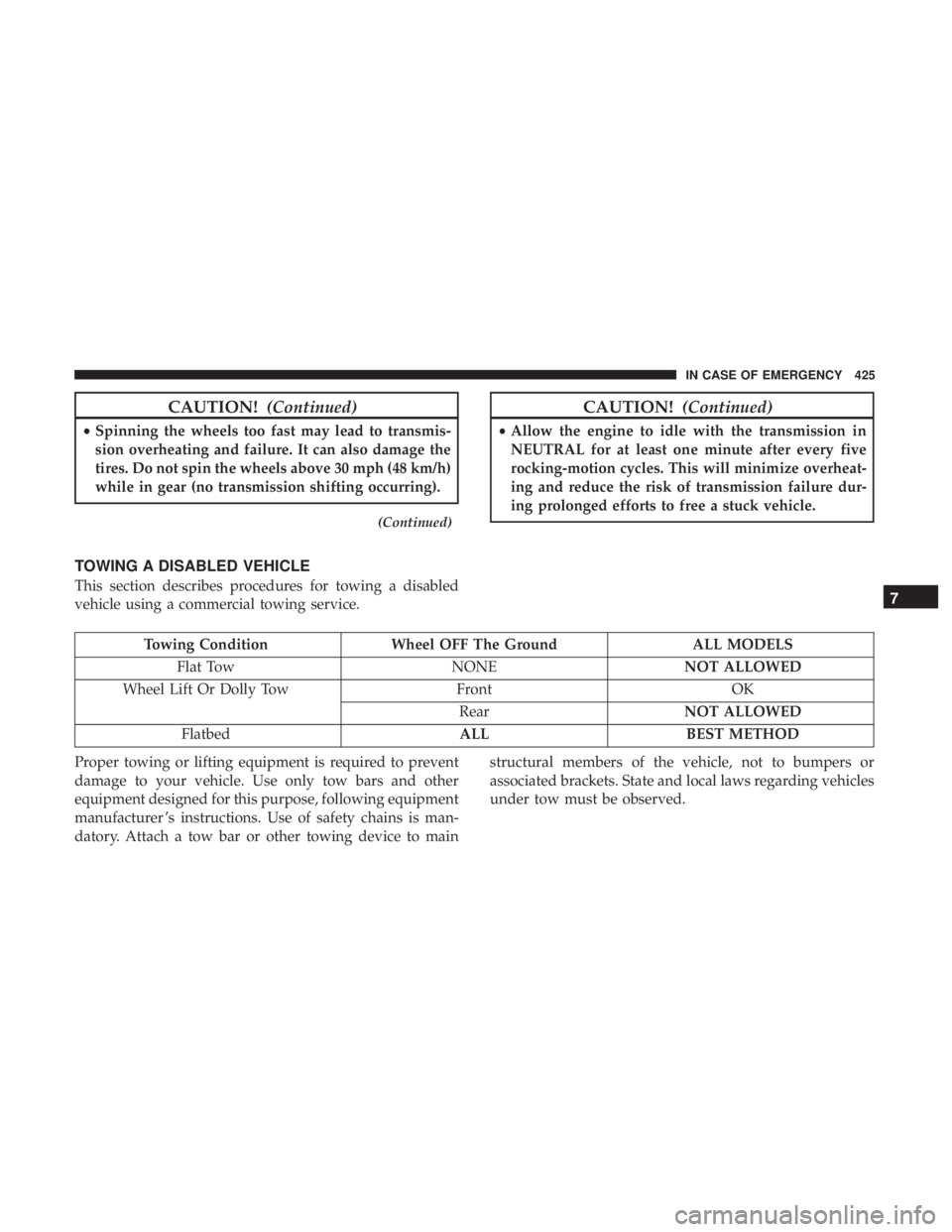
CAUTION!(Continued)
•Spinning the wheels too fast may lead to transmis-
sion overheating and failure. It can also damage the
tires. Do not spin the wheels above 30 mph (48 km/h)
while in gear (no transmission shifting occurring).
(Continued)
CAUTION! (Continued)
•Allow the engine to idle with the transmission in
NEUTRAL for at least one minute after every five
rocking-motion cycles. This will minimize overheat-
ing and reduce the risk of transmission failure dur-
ing prolonged efforts to free a stuck vehicle.
TOWING A DISABLED VEHICLE
This section describes procedures for towing a disabled
vehicle using a commercial towing service.
Towing Condition Wheel OFF The Ground ALL MODELS
Flat Tow NONENOT ALLOWED
Wheel Lift Or Dolly Tow FrontOK
Rear NOT ALLOWED
Flatbed ALLBEST METHOD
Proper towing or lifting equipment is required to prevent
damage to your vehicle. Use only tow bars and other
equipment designed for this purpose, following equipment
manufacturer ’s instructions. Use of safety chains is man-
datory. Attach a tow bar or other towing device to main structural members of the vehicle, not to bumpers or
associated brackets. State and local laws regarding vehicles
under tow must be observed.
7
IN CASE OF EMERGENCY 425
Page 454 of 614
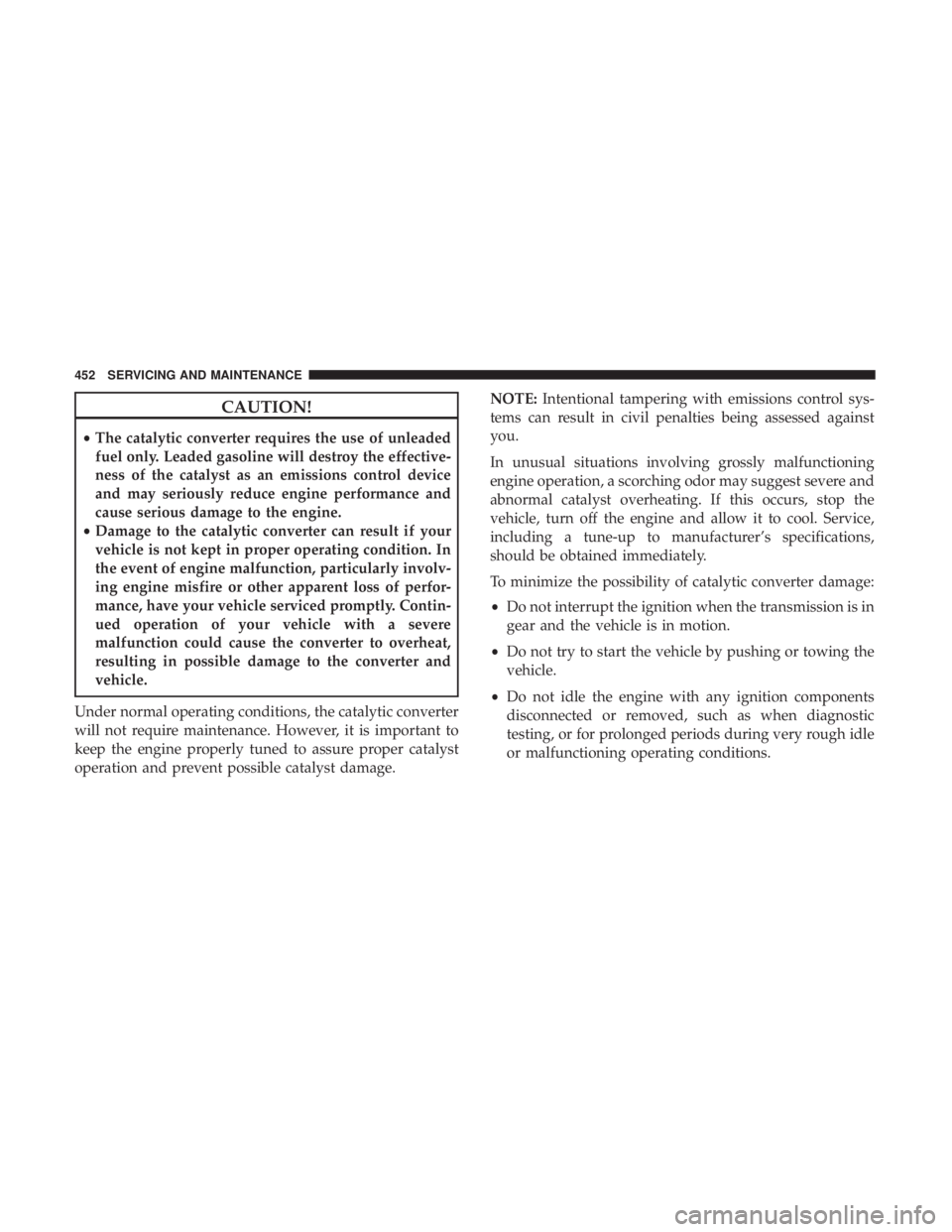
CAUTION!
•The catalytic converter requires the use of unleaded
fuel only. Leaded gasoline will destroy the effective-
ness of the catalyst as an emissions control device
and may seriously reduce engine performance and
cause serious damage to the engine.
• Damage to the catalytic converter can result if your
vehicle is not kept in proper operating condition. In
the event of engine malfunction, particularly involv-
ing engine misfire or other apparent loss of perfor-
mance, have your vehicle serviced promptly. Contin-
ued operation of your vehicle with a severe
malfunction could cause the converter to overheat,
resulting in possible damage to the converter and
vehicle.
Under normal operating conditions, the catalytic converter
will not require maintenance. However, it is important to
keep the engine properly tuned to assure proper catalyst
operation and prevent possible catalyst damage. NOTE:
Intentional tampering with emissions control sys-
tems can result in civil penalties being assessed against
you.
In unusual situations involving grossly malfunctioning
engine operation, a scorching odor may suggest severe and
abnormal catalyst overheating. If this occurs, stop the
vehicle, turn off the engine and allow it to cool. Service,
including a tune-up to manufacturer’s specifications,
should be obtained immediately.
To minimize the possibility of catalytic converter damage:
• Do not interrupt the ignition when the transmission is in
gear and the vehicle is in motion.
• Do not try to start the vehicle by pushing or towing the
vehicle.
• Do not idle the engine with any ignition components
disconnected or removed, such as when diagnostic
testing, or for prolonged periods during very rough idle
or malfunctioning operating conditions.
452 SERVICING AND MAINTENANCE
Page 473 of 614
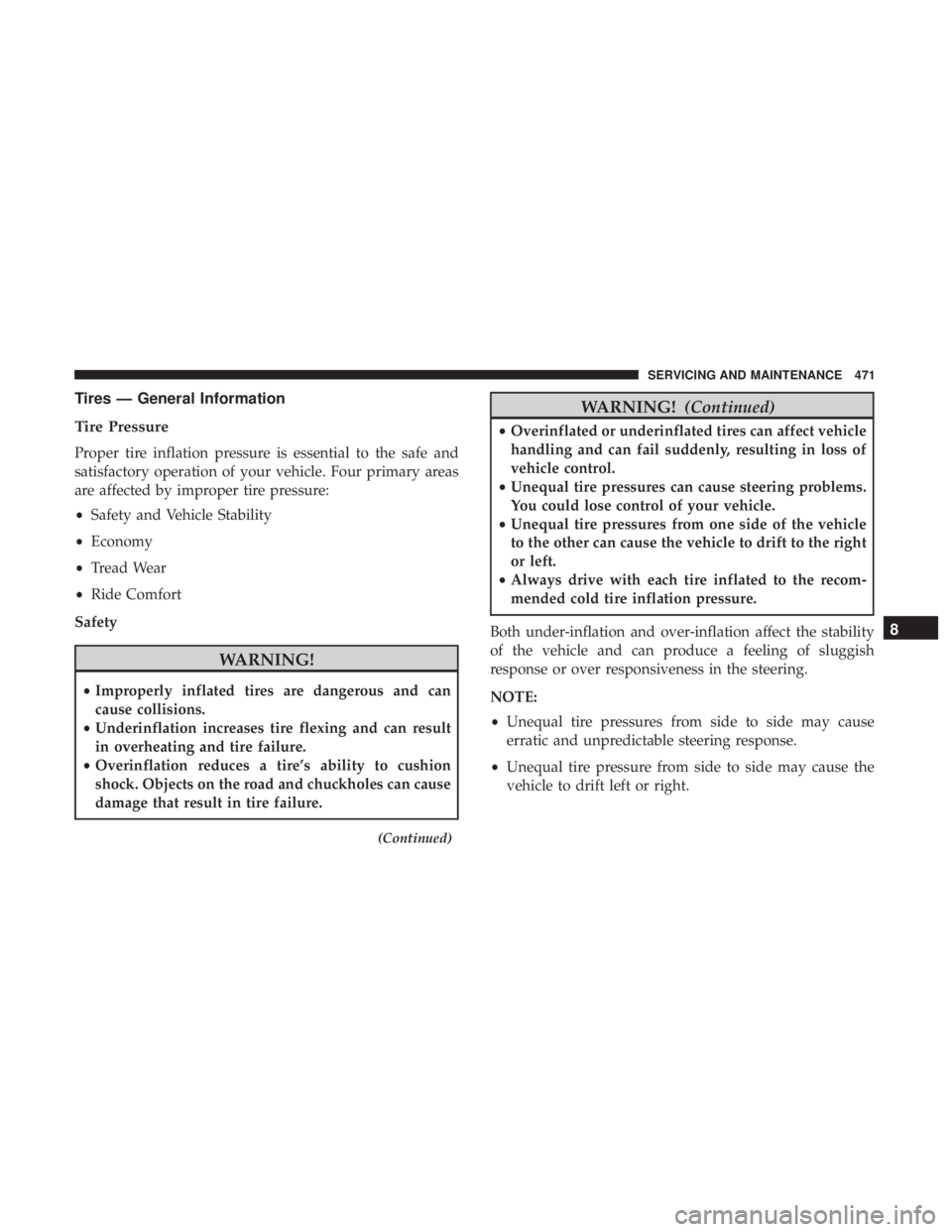
Tires — General Information
Tire Pressure
Proper tire inflation pressure is essential to the safe and
satisfactory operation of your vehicle. Four primary areas
are affected by improper tire pressure:
•Safety and Vehicle Stability
• Economy
• Tread Wear
• Ride Comfort
Safety
WARNING!
• Improperly inflated tires are dangerous and can
cause collisions.
• Underinflation increases tire flexing and can result
in overheating and tire failure.
• Overinflation reduces a tire’s ability to cushion
shock. Objects on the road and chuckholes can cause
damage that result in tire failure.
(Continued)
WARNING! (Continued)
•Overinflated or underinflated tires can affect vehicle
handling and can fail suddenly, resulting in loss of
vehicle control.
• Unequal tire pressures can cause steering problems.
You could lose control of your vehicle.
• Unequal tire pressures from one side of the vehicle
to the other can cause the vehicle to drift to the right
or left.
• Always drive with each tire inflated to the recom-
mended cold tire inflation pressure.
Both under-inflation and over-inflation affect the stability
of the vehicle and can produce a feeling of sluggish
response or over responsiveness in the steering.
NOTE:
• Unequal tire pressures from side to side may cause
erratic and unpredictable steering response.
• Unequal tire pressure from side to side may cause the
vehicle to drift left or right.
8
SERVICING AND MAINTENANCE 471
Page 599 of 614
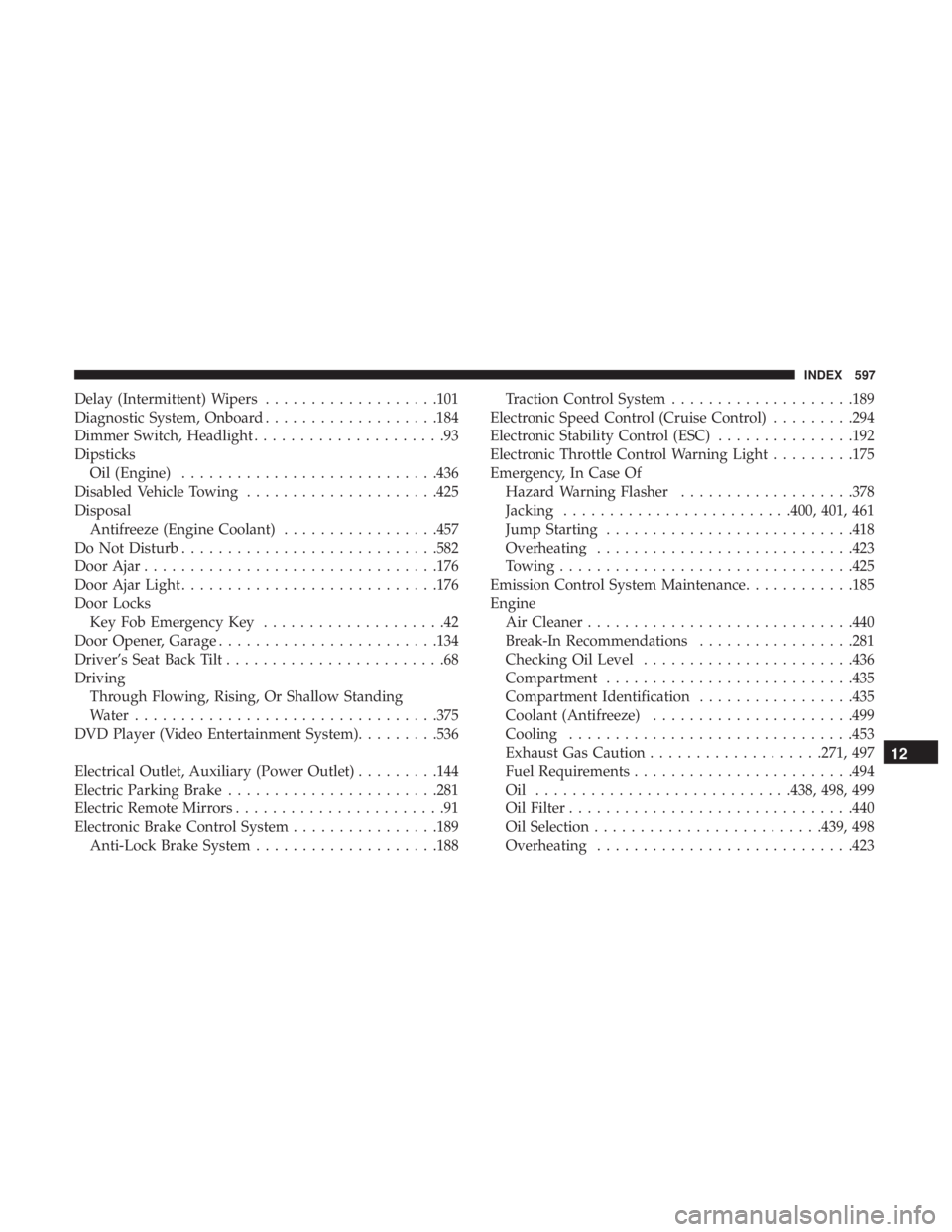
Delay (Intermittent) Wipers...................101
Diagnostic System, Onboard ...................184
Dimmer Switch, Headlight .....................93
Dipsticks Oil (Engine) ........................... .436
Disabled Vehicle Towing .....................425
Disposal Antifreeze (Engine Coolant) .................457
Do Not Disturb ........................... .582
Door Ajar ............................... .176
Door Ajar Light ........................... .176
Door Locks Key Fob Emergency Key ....................42
Door Opener, Garage ....................... .134
Driver’s Seat Back Tilt ........................68
Driving Through Flowing, Rising, Or Shallow Standing
Water ................................ .375
DVD Player (Video Entertainment System) .........536
Electrical Outlet, Auxiliary (Power Outlet) .........144
Electric Parking Brake ...................... .281
Electric Remote Mirrors .......................91
Electronic Brake Control System ................189
Anti-Lock Brake System ....................188 Traction Control System
....................189
Electronic Speed Control (Cruise Control) .........294
Electronic Stability Control (ESC) ...............192
Electronic Throttle Control Warning Light .........175
Emergency, In Case Of Hazard Warning Flasher ...................378
Jacking ........................ .400, 401, 461
Jump Starting .......................... .418
Overheating ........................... .423
Towing ............................... .425
Emission Control System Maintenance ............185
Engine Air Cleaner ............................ .440
Break-In Recommendations .................281
Checking Oil Level ...................... .436
Compartment .......................... .435
Compartment Identification .................435
Coolant
(Antifreeze) ..................... .499
Cooling .............................. .453
Exhaust Gas Caution ...................271, 497
Fuel Requirements ....................... .494
Oil ........................... .438, 498, 499
Oil Filter .............................. .440
Oil Selection ........................ .439, 498
Overheating ........................... .423
12
INDEX 597
Page 604 of 614
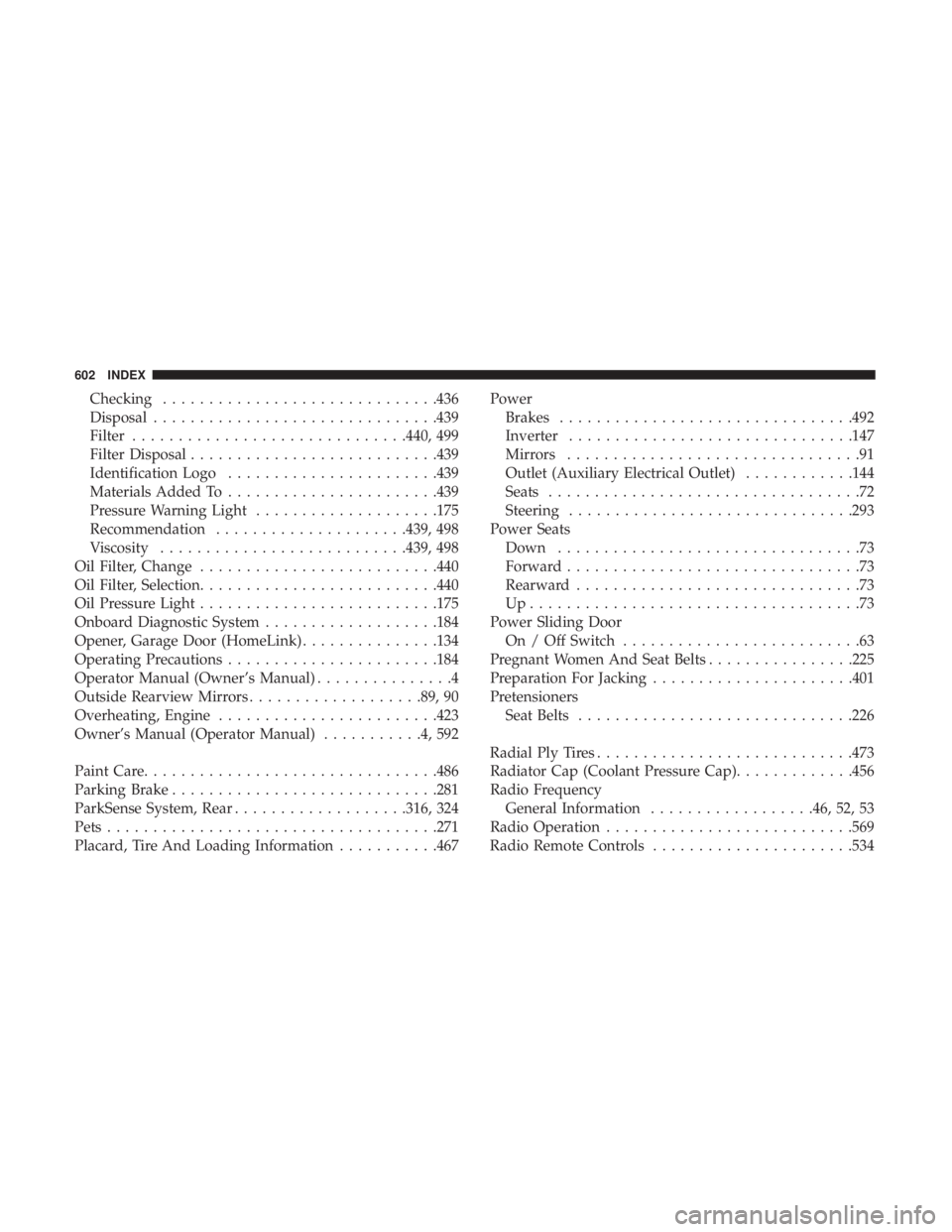
Checking............................. .436
Disposal .............................. .439
Filter ............................. .440, 499
Filter Disposal .......................... .439
Identification Logo ...................... .439
Materials Added To ...................... .439
Pressure Warning Light ....................175
Recommendation .....................439, 498
Viscosity .......................... .439, 498
Oil Filter, Change ......................... .440
Oil Filter, Selection ......................... .440
Oil Pressure Light ......................... .175
Onboard Diagnostic System ...................184
Opener, Garage Door (HomeLink) ...............134
Operating Precautions ...................... .184
Operator Manual (Owner’s Manual) ...............4
Outside Rearview Mirrors ...................89, 90
Overheating, Engine ....................... .423
Owner’s Manual (Operator Manual) ...........4,592
Paint Care ............................... .486
Parking Brake ............................ .281
ParkSense System, Rear ...................316, 324
Pets ................................... .271
Placard, Tire And Loading Information ...........467Power
Brakes ............................... .492
Inverter .............................. .147
Mirrors ................................91
Outlet (Auxiliary Electrical Outlet) ............144
Seats ..................................72
Steering .............................. .293
Power Seats Down .................................73
Forward ................................73
Rearward ...............................73
Up....................................73
Power Sliding Door On / Off Switch ..........................63
Pregnant Women And Seat Belts ................225
Preparation For Jacking ..................... .401
Pr
etensionersSeat Belts ............................. .226
Radial Ply Tires ........................... .473
Radiator Cap (Coolant Pressure Cap) .............456
Radio Frequency General Information ..................46, 52, 53
Radio Operation .......................... .569
Radio Remote Controls ..................... .534
602 INDEX